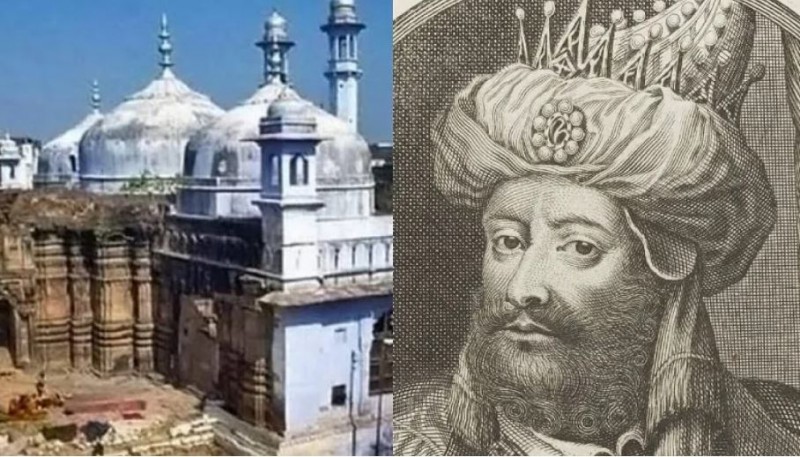
During the reign of Aurangzeb Alamgir, the Mughal Empire witnessed a significant shift in its religious policies, particularly regarding Hindu temples and mosques. Aurangzeb, who ruled from 1658 to 1707, implemented stringent measures against Hindu temples, resulting in the destruction of numerous sacred sites across the Indian subcontinent. This period marked a tumultuous chapter in Indian history, characterized by religious intolerance and cultural upheaval.
Kashi Vishwanath Temple:
One of the most notable instances of Aurangzeb's policies was the demolition of the revered Kashi Vishwanath Temple in Varanasi. In 1669, Aurangzeb ordered the destruction of this ancient Hindu temple and the construction of the Gyanvapi Mosque on its site. The temple, dedicated to Lord Shiva, held immense spiritual significance for Hindus. Despite the destruction, remnants of the original temple, including foundations, pillars, and structures behind the mosque, still stand as a testament to its former glory. Today, the Kashi Vishwanath Temple that devotees worship at is located nearby, with its construction overseen by Ahilyabai Holkar in 1780.
Keshavdev Temple:
Similarly, Aurangzeb targeted the Keshavdev Temple in Mathura, another sacred site for Hindus. In 1670, Aurangzeb ordered the demolition of this temple and replaced it with the Eidgah Mosque. The destruction of the temple resulted in the loss of invaluable treasures, symbolizing Aurangzeb's disregard for religious diversity and cultural heritage.
Bisheshwar Temple:
In Varanasi, Aurangzeb's religious intolerance extended to the Bisheshwar Temple, where he ordered the construction of a mosque at its sacred site. The mosque, built with stones from the demolished temple, stands as a stark reminder of Aurangzeb's efforts to suppress Hindu worship. Additionally, Aurangzeb commissioned mosques in Mathura, further erasing Hindu religious symbols from the landscape.
Vijay Mandir:
The Bijamandal Temple, also known as Vijay Mandir Temple, located in Vidisha, fell victim to Aurangzeb's religious policies. After its destruction in 1682, Aurangzeb ordered the construction of the Alamgiri Mosque on the temple's site, utilizing materials salvaged from the demolished structure. This exemplifies Aurangzeb's systematic approach to replacing Hindu temples with mosques, further consolidating Mughal authority.
Golkonda (Andhra Pradesh):
The capture of Golconda by Aurangzeb led to the appointment of Abdur Rahim Khan as the governor of Hyderabad. Under Aurangzeb's directives, Khan oversaw the destruction of Hindu temples and the construction of mosques on their sites, reflecting the widespread implementation of Aurangzeb's religious policies across the empire.
Sarhind (Punjab):
In a village under the Sarhind jurisdiction, a Sikh temple was demolished and replaced with a mosque, highlighting Aurangzeb's targeting of religious minorities and their sacred sites.
Somnath Temple:
The Somnath Temple, located in Gujarat, suffered destruction twice during Aurangzeb's reign. Initially demolished in 1665, Aurangzeb's forces found Hindus still worshiping at the site, prompting further punitive actions. Aurangzeb's relentless pursuit to eradicate Hindu temples and suppress religious practices resulted in widespread devastation and loss of cultural heritage.
Additionally, mosques were constructed on the sites of demolished temples in various regions:
After the fall of Golconda, Aurangzeb ordered the construction of the Makkah Masjid using materials from 200 temples.
Seventeen mosques were built on temple sites in Hubli in 1675.
The Jamia Masjid in Maharashtra's Amaravati district was built on the site of a Hindu temple, which was later reconstructed in 1878 with the help of local Muslims.
Aurangzeb had mosques constructed at Hanuman Garhi and Thakur Mandir sites in Ayodhya.
In conclusion, Aurangzeb's reign marked a dark period in Indian history, characterized by religious intolerance and cultural destruction. His policies regarding Hindu temples and mosques reflect the complexities of religious identity and power dynamics within the Mughal Empire, leaving a lasting impact on India's social and religious landscape.
PM Modi to Inaugurate Supreme Court's Diamond Jubilee Celebration on Sunday
Kerala's Thiruvananthapuram Airport Receives Excellence Award
SC Halts Calcutta High Court Proceedings in Medical Admissions Case